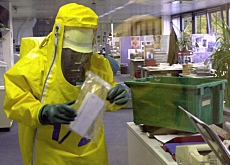
Scientists seek answers blowing in the wind

Aerobiology, or the study of the origins, effects and travels of biological particles in the air, is the focus of an international conference in Neuchâtel this week.
Scientists have gathered to discuss the wide-ranging implications of aerobiology, which extends far beyond pollen and hay fever.
Think pollen – and maybe fungal spores – and you’ll probably think of allergies. For many people, this is how their lives are affected by these tiny particles.
Around 15 per cent of the population in most industrialised nations suffer from airborne allergies such as hay fever. To counter this, the Swiss national weather service MeteoSwiss has analysed pollen levels since the early 1990s, making it a pioneer in the field.
Its regular bulletins allow doctors and patients to mitigate the effects on people’s health.
One type of pollen alert that has made the news in recent years has been for ragweed. MeteoSwiss was able to determine that this plant was headed for Switzerland, and researchers were able to pinpoint its arrival in the late 1990s.
But researchers say much more is happening out in the atmosphere, and with far more wide-ranging effects than just weepy eyes, a runny nose and difficulty breathing.
Scientists interested in aerobiology are just as likely to drop buzzwords such as bioterrorism, climate change, pollution or genetically modified organisms into a conversation about their work.
Agriculture
Agriculture is perhaps the sector that has benefited the most from the development of the field. Pollen measurements during flowering season allow for predictions of crop yield, and help plan crop-dusting and harvests.
It has also helped track the progression of fungi such as soybean rust in North America. Spores of this crop disease, which kills the plants it infects, are believed to have arrived from South America, carried by Hurricane Ivan in 2004.
“Aerobiological models allow us to say where the disease will strike,” said Paul Comtois of Montreal University. “In 2005, $100 million (SFr123 million) was saved on crop protection alone.”
But because they depend heavily on weather models, researchers admit that at best they can determine which regions are at risk.
Scientists are also starting to consider the combined effects of pollution and biological particles. While the chemistry of atmospheric pollutants is quite different to say, pollen, the two can combine and react.
“Some sufferers of asthma [caused by pollen allergies] seem to feel more if pollution levels are high,” added Comtois. “The symptoms are worse than if effects of pollution and pollen were simply added together.”
Terrorism
Specialists have also been asked whether pollen from genetically modified plants can be easily propagated. But the answer is not likely to satisfy everyone.
“The risks vary from plant to plant and region to region,” said Philippe Küpfer of Neuchâtel University. “Pollen from wheat and cabbage only travels a few metres for example, while for other plants it goes much further.”
More recently, aerobiology has turned its sights on fighting crime and combating potential bioterrorism such as attacks using anthrax spores.
“Methods for detecting a biological terrorist attack are much the same as the ones we used to detect the arrival of ragweed,” said Bernard Clot of MeteoSwiss. “We detect changes in the composition of the air.”
According to Clot, these methods are not efficient enough for the people who want answers – the armed forces. “They usually want a machine that immediately gives them a ‘yes’ or ‘no’ answer,” he added.
Aerobiologists aren’t necessarily convinced that the threat is as real as the military might say.
“There is certainly a risk if a terrorist manages to produce spores for a biological weapon,” admitted Clot. “But even if this was the case, they would find it difficult to produce a big enough quantity to be dangerous and release it efficiently.”
swissinfo, Scott Capper in Neuchâtel
Pollen is usually made up of small, light, dry protein particles from trees, grasses, flowers, and weeds that may be spread by the wind.
Pollen particles are usually the male sex cells of the plant, and are smaller than the tip of a pin.
They are also a potent stimulator of allergic responses.
A spore is a reproductive cell produced by plants as well as some bacteria.
Certain bacteria produce spores as a defensive mechanism.
Chemical disinfection kills bacteria, but does not destroy their spores.

In compliance with the JTI standards
More: SWI swissinfo.ch certified by the Journalism Trust Initiative






























You can find an overview of ongoing debates with our journalists here . Please join us!
If you want to start a conversation about a topic raised in this article or want to report factual errors, email us at english@swissinfo.ch.